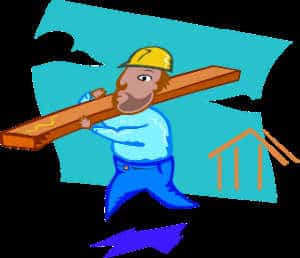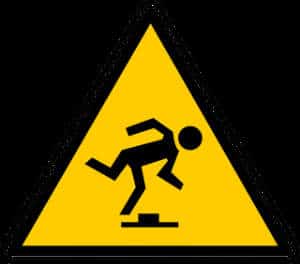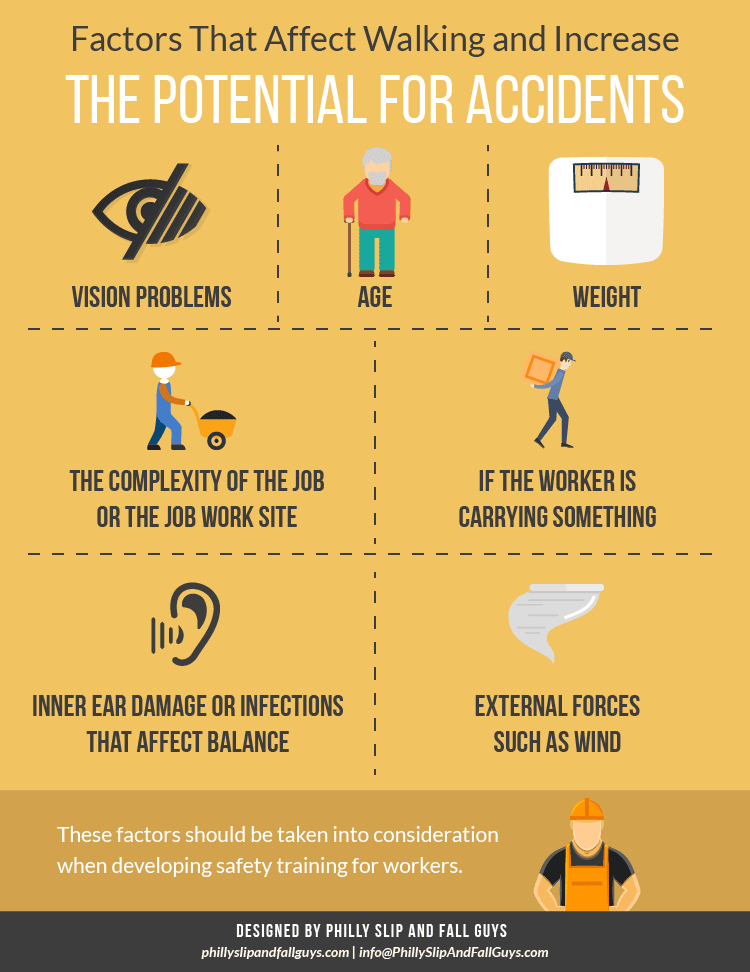Increasing Worker Knowledge About Slip, Trip, & Falls
As a general rule, construction companies want to increase workplace safety while decreasing construction accidents. Until recently, safety training was usually very generic and focused on important topics but in very general ways. There has been a recent focus on slip, trip, and fall accidents in construction workplaces and the study of motion, of the gait of a worker, is the central theme of these new studies. It is possible to reduce slip and fall accidents by changing the way workers are trained for safety and doing more location-specific training.
The Real Dangers of Slip, Trip, and Fall Accidents
It is estimated that 65 percent of all slip and fall accidents occur while walking or running on a flat surface. These are referred to as same-level falls, and they are very common in the wholesale, service, and retail industries. It also estimated that one in every six lost time workplace accidents are slip and fall accidents. An interesting fact associated with workplace slip and fall accidents is that 70 percent of those accidents involve people who have been working at their job one year or less.
The fact is that construction accidents classified as slip and fall incidents have increased in the construction industry over the past couple of decades. While every construction company does the traditional slip and fall training that includes wearing the right shoes and watching where you are going, the reality is that this type of training only touches the surface of the real problems and does not offer real solutions.
The Way a Worker Walks
When you are trying to raise worker awareness to slip and fall accidents, you start by appreciating the statistic that says that seven out of every 10 slip and fall accidents in the workplace occur with people who have worked for the company for less than a year. In the study of these types of accidents, the way a worker walks is directly related to the frequency of slip and fall accidents. To some, this can sound like science mumbo jumbo, but there has been a lot of research to back this up.
Swinging With The Gait
When a construction worker is unfamiliar with a work site, they tend to use a careless gait that does not match the safety needs of the situation. A worker who is familiar with a particular work area will use a gait that speeds up and slows down in relation to the obstacles and general walking hazards that are presented. A worker who is new to a work site will use only one gait, and that is going to lead to problems.
Recent studies have shown that experienced construction workers are more cautious around new job sites because they don’t know what to expect. Once they feel comfortable walking in certain areas, they walk with less caution. While this seems to be the ideal way to do things, the dynamic nature of construction sites can make careless walking very dangerous.
The Wiring of the Brain
Construction accidents can be avoided when workers learn from past mistakes. If someone makes a mistake with a piece of equipment and that leads to an accident, then that worker learns not to make that mistake ever again. That is how the brain is wired, but this does not seem to apply to walking. If a worker slips and falls on a construction site, they will remember that they fell, but they usually do not remember the steps they took that lead to the fall. Remembering those steps is how to prevent future slip and fall accidents, but honing that memory is not a part of construction training.
This idea of remembering the steps we took prior to a slip and fall accident is important because without retaining that memory, we will subconsciously make the same mistake over and over again. Walking is a natural act that most people take for granted. Trying to get construction workers to program their brains to remember the steps they took before an accident is difficult, but it could wind up being the key to preventing slip and fall accidents.
Training to Protect Against Slip and Fall Accidents
While making sure workers have the right footwear on and are conscious of safety signs regarding walking hazards is important, what is really important is helping workers to learn how to walk safely in a construction environment. Instead of workers taking walking for granted, they need to be trained to consciously scan a room for walking hazards and learn to adjust their gait to move through an area safely.
Sometimes this type of training is just a matter of having workers go through areas of the work site and forcing them to analyze each step before moving forward. But the danger in too much repetition with training is that any obstacle that remains in place for an extended period of time eventually becomes invisible to workers. As they scan for obstacles, anything that has been in place for a while can be taken for granted and, once again, they find themselves in a dangerous situation.
The Factors That Affect Perception
Not only is it difficult to retrain a construction worker on how to walk properly and analyze their surroundings, but there are also certain factors at work that make it more difficult to train workers to walk safely. The list of factors that affect walking and increases the potential for accidents includes:
- Inner ear damage or infections that affect balance
- Vision problems
- Age
- Weight (weight shifts during walking and more weight makes controlled walking difficult)
- The complexity of the job or the job work site
- If the worker is carrying something
- External forces such as wind or the application of force by a moving object
When developing training to get workers to consciously monitor their walking habits, all of these factors need to be taken into consideration for the training to be successful. This not only makes the training more complex, but it can also make it more difficult for workers to comprehend the process.
Scientific research is helping to get to the core of construction accidents and offer real solutions to dangerous problems. Slip, trip, and fall accidents are the most frequent types of accidents that occur on a construction site, yet they are the least understood types of accidents in the industry. The problem is not necessarily the lack of good footwear or a worker not paying attention to where they are going, it is the mechanics of the way a worker walks when faced with obstacles they can trip over.
By using a new type of training that makes workers conscious of their own walking mechanics and teaching workers how to properly walk when working, there exists a real possibility for almost eliminating these types of accidents completely.
Share this Image On Your Site
